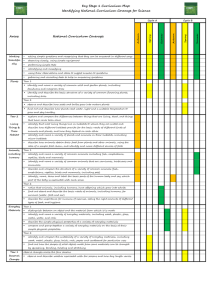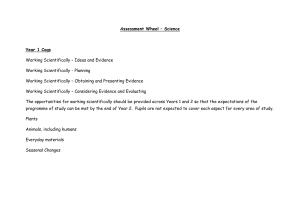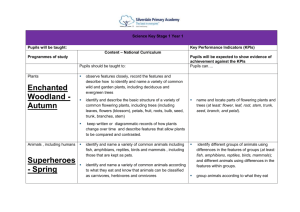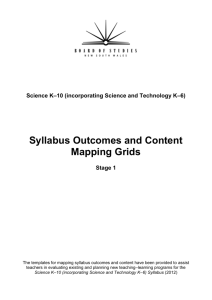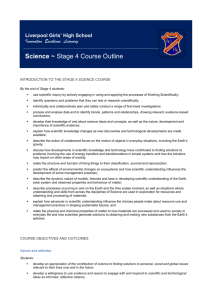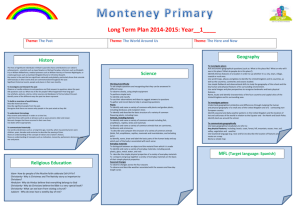Science outcomes and content mapping grid S2
advertisement
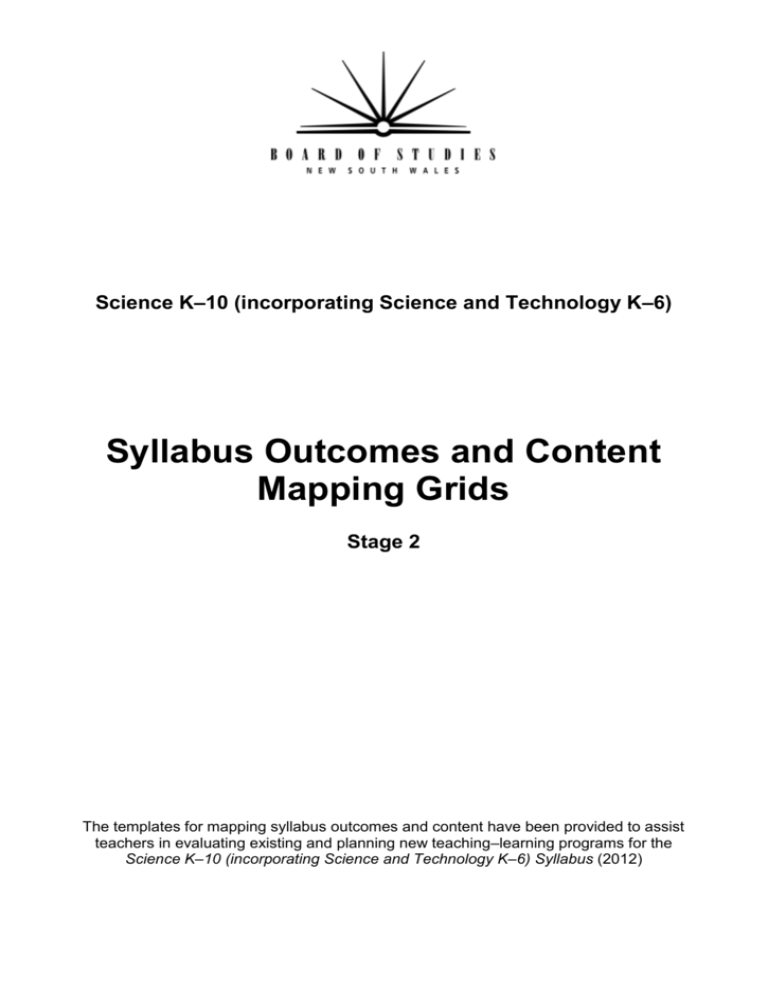
Science K–10 (incorporating Science and Technology K–6) Syllabus Outcomes and Content Mapping Grids Stage 2 The templates for mapping syllabus outcomes and content have been provided to assist teachers in evaluating existing and planning new teaching–learning programs for the Science K–10 (incorporating Science and Technology K–6) Syllabus (2012) Outcomes Mapping Grid – Stage 2 Knowledge and understanding Skills Values and attitudes Outcome A student: 1 ST2-1VA shows interest in and enthusiasm for science and technology, responding to their curiosity, questions and perceived needs, wants and opportunities ST2-2VA demonstrates a willingness to engage responsibly with local, national and global issues relevant to their lives, and to shaping sustainable futures ST2-3VA develops informed attitudes about the current and future use and influence of science and technology based on reason ST2-4WS investigates their questions and predictions by analysing collected data, suggesting explanations for their findings, and communicating and reflecting on the processes undertaken ST2-5WT applies a design process and uses a range of tools, equipment, materials and techniques to produce solutions that address specific design criteria ST2-6PW identifies ways heat is produced and that heat moves from one object to another ST2-7PW describes everyday interactions between objects that result from contact and non-contact forces ST2-8ES describes some observable changes over time on the Earth’s surface that result from natural processes and human activity ST2-9ES describes how relationships between the sun and the Earth cause regular changes describes that living things have life cycles, can be ST2-10LW distinguished from non-living things and grouped, based on their observable features describes ways that science knowledge helps people ST2-11LW understand the effect of their actions on the environment and on the survival of living things ST2-12MW identifies that adding or removing heat causes a change of state between solids and liquids ST2-13MW identifies the physical properties of natural and processed materials, and how these properties influence their use ST2-14BE describes how people interact within built environments and the factors considered in their design and construction ST2-15I describes ways that information solutions are designed and produced, and factors to consider when people use and interact with information sources and technologies ST2-16P describes how products are designed and produced, and the ways people use them Page 2 of 11 Year 3 Year 4 Unit Unit 2 3 4 1 2 3 4 Content Mapping Grid – Stage 2 Working Scientifically 1 Year 3 Year 4 Unit Unit 2 3 4 1 2 3 A student investigates their questions and predictions by analysing collected data, suggesting explanations for their findings, and communicating and reflecting on the processes undertaken ST2-4WS Students question and predict by: using curiosity, prior knowledge, experiences and scientific information with guidance, identifying questions in familiar contexts that can be investigated scientifically (ACSIS053, ACSIS064) predicting what might happen based on prior knowledge in an investigation (ACSIS053, ACSIS064) Students plan investigations by: working collaboratively and individually, to suggest ways to plan and conduct investigations to find answers to questions (ACSIS054, ACSIS065) suggesting appropriate materials, tools and equipment they could use in conducting their investigations and recording their findings, identifying appropriate safety rules identifying where Working Scientifically might inform or test elements of Working Technologically in relation to established criteria Content Students conduct investigations by: following the planned method, adjusting procedures as necessary, including exploration, fieldwork, surveys and researching secondary sources safely using appropriate materials, tools or equipment to make and record observations, using formal measurements and digital technologies as appropriate (ACSIS055, ACSIS066) using a range of methods to record observations and measurements with care and honesty, including tables and formal units for length, time and mass Students process and analyse data and information by: using a range of methods including tables and simple column graphs to represent data and to identify patterns and trends, using digital technologies as appropriate (ACSIS057, ACSIS068) sharing their findings and reflecting on the investigation, including whether a test was fair or not (ACSIS058, ACSIS069) describing patterns and relationships in data collected from investigations (ACSHE050, ACSHE061) comparing results with predictions, suggesting possible reasons for findings (ACSIS215, ACSIS216) using their ideas and findings to identify what they could find out next through the processes of Working Scientifically and Working Technologically Students communicate by: representing and communicating ideas and findings in a variety of ways such as diagrams, physical representations and simple reports, tables, simple column graphs, written and oral factual texts, explanation and argument (ACSIS060, ACSIS071) sharing what they did and found out, including identifying some strengths and limitations of the method they used and what could be done differently to improve their investigation, including fairness as appropriate Page 3 of 11 4 Content Mapping Grid – Stage 2 Working Technologically 1 Year 3 Year 4 Unit Unit 2 3 4 1 2 A student applies a design process and uses a range of tools, equipment, materials and techniques to produce solutions that address specific design criteria ST2-5WT Students explore and define a task by: exploring design situations and/or existing solutions relevant to the needs and wants of themselves and others working individually and collaboratively to develop a design brief that identifies simple design criteria relating to requirements that make the proposed solution useful and attractive while having minimal impact on the environment Content Students generate and develop ideas by: using creative thinking techniques, including brainstorming, mind-mapping, sketching and modelling using a range of research techniques to access information relevant to the task using techniques, including labelled drawings, modelling and storyboarding, for documenting and communicating design ideas using digital technologies and multimedia for communicating design ideas refining ideas in responding to feedback from others Students produce solutions by: exploring a range of materials appropriate for the task developing and applying a plan and sequence for production that considers, where relevant, time and resources safely and correctly using a range of tools and equipment, materials and techniques, eg cutting, combining, joining, shaping, assembling and finishing materials Students evaluate by: reflecting on the process followed and what could be done differently to ensure that the solution meets the needs of the user/audience using established design criteria to evaluate the process, product or solution, and suggesting how their design solution could be improved reflecting on findings to identify what they could find out next through the processes of Working Technologically and Working Scientifically Page 4 of 11 3 4 Content Mapping Grid – Stage 2 Year 3 Year 4 Unit Unit Physical World 1 2 3 4 1 2 3 4 A student: identifies ways heat is produced and that heat moves from one object to another ST2-6PW describes everyday interactions between objects that result from contact and non-contact forces ST2-7PW Heat can be produced in many ways and can move from one object to another. (ACSSU049) Content Students: identify in their environment some different ways in which heat is produced, eg by electricity, burning (chemical) and friction (motion) observe the effects of heat moving from one object to another, eg the feeling when hands are placed in warm or cold water describe how people use scientific knowledge in their work and everyday life to control the movement of heat from one object to another, eg a pot holder, insulated bags or thermos Forces can be exerted by one object on another through direct contact or from a distance. (ACSSU076) Students: investigate the effect of forces on the behaviour of objects, eg dropping, bouncing or rolling objects observe the way the force of gravity pulls objects towards the Earth, eg dropping objects from different heights observe everyday situations where the direct contact force (friction) affects the movement of objects on different surfaces, eg a bike or skateboard carry out tests to investigate the forces of attraction and repulsion between magnets Page 5 of 11 Content Mapping Grid – Stage 2 Year 3 Year 4 Unit Unit Earth and Space 1 2 3 4 1 2 3 A student: describes some observable changes over time on the Earth’s surface that result from natural processes and human activity ST2-8ES describes how relationships between the sun and the Earth cause regular changes ST2-9ES Earth's surface changes over time as a result of natural processes and human activity. (ACSSU075) Content Students: use appropriate tools and equipment to collect and record data about some changes in natural conditions, eg tides, daily temperature, rainfall and wind investigate how change in the environment is used by Aboriginal and Torres Strait Islander peoples to develop seasonal calendars describe some changes in the landscape that have occurred over time as a result of natural processes, eg erosion by wind and water research changes that have occurred in a local environment in Australia or an Asian region as a result of human activities, eg increasing erosion, construction of built environments and regeneration of an area Earth's rotation on its axis causes regular changes, including night and day. (ACSSU048) Students: demonstrate that the rotation of the Earth on its axis is the cause of night and day, eg by using models of the Earth and sun describe local seasonal changes that occur as a result of the Earth's movement around the sun observe and record changes in the length and direction of a shadow during the day to show how the movement of the Earth around the sun can be used to measure time, eg by using a shadow clock or sundial Page 6 of 11 4 Content Mapping Grid – Stage 2 Year 3 Year 4 Unit Unit Living World 1 2 3 4 1 2 3 A student: describes that living things have life cycles, can be distinguished from non-living things and grouped, based on their observable features ST2-10LW describes ways that science knowledge helps people understand the effect of their actions on the environment and on the survival of living things ST2-11LW Living things can be grouped on the basis of observable features and can be distinguished from non-living things. (ACSSU044) Students: sort objects according to whether they are living or non-living identify some features of living things that distinguish them from non-living things, eg reproducing, growing and responding to stimuli identify and use patterns in the observable features of living things to group them, by using tables, diagrams or flowcharts research ways that Aboriginal and Torres Strait Islander peoples classify some plants or animals Living things have life cycles. (ACSSU072) Content Students: observe first-hand one animal or plant as it grows and develops, and sequence the stages in its life cycle identify ways that the environment can affect the life cycle of plants and animals Living things, including plants and animals, depend on each other and the environment to survive. (ACSSU073) Students: identify some factors in the local environment that are needed by plants and animals for survival outline the relationship between plants and animals, including that plants are able to use light to make food, while animals must eat plants or other animals to obtain food investigate the role of living things in a habitat, eg plants as producers and microbes (micro-organisms) as decomposers gather information about some relationships between living things, eg predator-prey, competitors and mutually beneficial relationships predict the effect of natural changes in the environment on some relationships between plants and animals, eg drought and fire describe some examples of how science knowledge helps people to understand the effect of their actions on the environment and the survival of living things (ACSHE051, ACSHE062) Page 7 of 11 4 Content Mapping Grid – Stage 2 Material World 1 Year 3 Year 4 Unit Unit 2 3 4 1 2 3 A student: identifies that adding or removing heat causes a change of state between solids and liquids ST2-12MW identifies the physical properties of natural and processed materials, and how these properties influence their use ST2-13MW A change of state between solid and liquid can be caused by adding or removing heat. (ACSSU046) Content Students: describe some everyday situations where solids and liquids change state by adding heat (heating) or removing heat (cooling) predict and observe the effects of adding heat or removing heat on a variety of everyday solids and/or liquids, eg butter, chocolate and water describe how scientific knowledge about the effects of heating and cooling is used by people in their everyday life, eg the types of clothes worn, the packaging and preparation of food and everyday devices, eg freezers, irons or cooktops Natural and processed materials have a range of physical properties which influence their use. (ACSSU074) Students: observe the changes that occur in the physical properties of everyday materials when they are heated, cooled, bent, stretched, folded and twisted observe and describe the structure of materials that can be seen with the naked eye and a magnifying glass, eg grains in bread, particles in chipboard or cork, threads within a fabric or fibres in paper identify the properties of some natural and processed materials describe how a range of common natural and processed materials are used in everyday life generate ideas about how the physical properties of some natural and processed materials influence their use Page 8 of 11 4 Content Mapping Grid – Stage 2 Built Environments 1 Year 3 Year 4 Unit Unit 2 3 4 1 2 3 A student describes how people interact within built environments and the factors considered in their design and construction ST2-14BE People interact in varying ways within built environments. Contents Students: observe how people interact within a built environment and describe how its design meets the needs of the users, eg the ways people use and interact in a local shopping centre or playground survey a range of places and spaces in local built environments and identify how people interact within them for a range of purposes for social and cultural reasons, eg use of the local hall for a school play or use of local playing fields for sport A range of factors needs to be considered when designing and constructing built environments. Students: examine some built environments, eg a local playground or shopping centre, and identify some factors that have been considered in the design, such as purpose, access, aesthetic and environmental considerations, and movement within the space describe how the design and construction of a built environment may be modified to better suit the needs of users Page 9 of 11 4 Content Mapping Grid – Stage 2 Year 3 Year 4 Unit Unit Information 1 2 3 4 1 2 3 A student describes ways that information solutions are designed and produced, and factors to consider when people use and interact with information sources and technologies ST2-15I There are processes and considerations involved in designing and producing information solutions. Content Students: use common digital technologies and applications to organise and communicate information for a specific task, eg word processing and digital presentation software investigate the effectiveness of an information solution for its intended use, eg a game or animated story book demonstrate how a variety of media can be combined to address the needs of a specific audience, eg combining visual images, sound and text in a digital presentation People interact with information sources and technologies in a variety of ways. Students: interview the users of an information solution and find out how the design has influenced their decisions and opinions, eg the design of advertisements explore how people use current and emerging technologies to communicate, access and record information, eg email, mobile phones, blogs and wikis A range of factors need to be considered when using information sources and technologies. Students: demonstrate appropriate safety and etiquette in relation to computer usage, eg general computer care, file security, maintaining confidentiality of passwords, printing and sharing resources acknowledge ownership of information when selecting and using information, eg citing sources Page 10 of 11 4 Content Mapping Grid – Stage 2 Products 1 Year 3 Year 4 Unit Unit 2 3 4 1 2 A student describes how products are designed and produced, and the ways people use them ST2-16P There are various processes involved in the ways products are designed and produced. Content Students: identify the component parts of a product and explain how the parts are designed to work together, eg pedals, cogs and chains work together to make bicycle wheels move examine the process used to produce an existing product by creating a flowchart from design to producing the finished product People use products in a variety of ways. Students: explore the ways existing products can be reused and recycled to incorporate environmental considerations, eg products designed from recycled PET bottles examine how people use applications of science and technology in their work, eg builders, farmers and graphic designers Page 11 of 11 3 4
